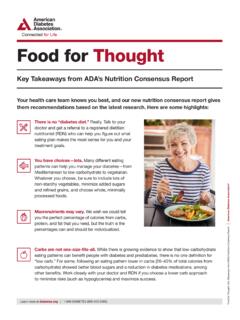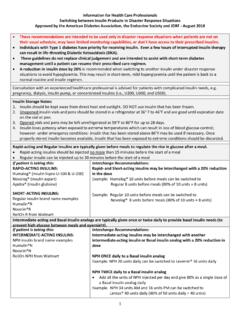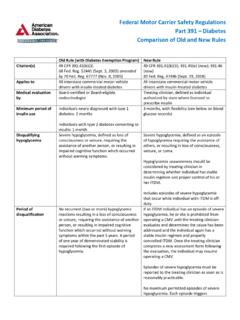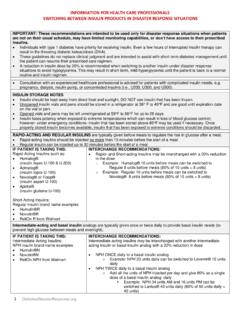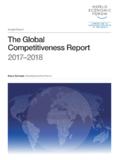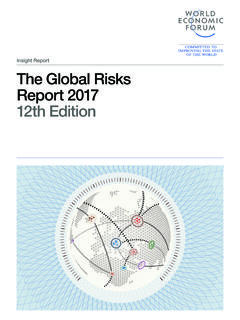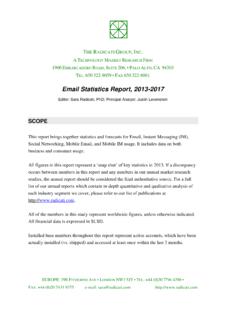Transcription of National Diabetes Statistics Report, 2017
1 National Diabetes Statistics report , 2017 . Estimates of Diabetes and Its Burden in the United States Background The National Diabetes Statistics report is a periodic publication of the Centers for Disease Control and Prevention (CDC) that provides updated Statistics about Diabetes in the United States for a scientific audience. It includes information on prevalence and incidence of Diabetes , prediabetes, risk factors for complications, acute and long-term complications, deaths, and costs. These data can help focus efforts to prevent and control Diabetes across the United States. This report was previously known as the National Diabetes Fact Sheet. Methods The estimates in this document (unless otherwise noted) were derived from various data systems of CDC, the Indian Health Service (IHS), the Agency for Healthcare Research and Quality (AHRQ), the Census Bureau, and published studies.
2 The estimated percentages and the total number of Fast Facts on people with Diabetes and prediabetes were derived from the National Diabetes Health and Nutrition Examination Survey (NHANES), National Health Interview Survey (NHIS), IHS National Data Warehouse (NDW), Behavioral million people Risk Factor Surveillance System (BRFSS), United States Diabetes Surveillance have Diabetes System (USDSS), and resident population estimates. ( of the population). Numbers and rates for acute and long-term complications of Diabetes were derived from the National Inpatient Sample (NIS) and National Emergency Department Sample (NEDS), as well as NHIS. Diagnosed Diabetes was Diagnosed determined by self- report among survey respondents and by diagnostic million people codes for American Indians and Alaska Natives who accessed IHS, tribal, or Urban Indian health facilities that submitted data to the IHS NDW.
3 Both fasting glucose and hemoglobin A1C (A1C) levels were used to derive Undiagnosed estimates for undiagnosed Diabetes and prediabetes. An alpha level of million was used when assessing statistical differences between groups. ( of people with Most estimates of Diabetes in this report do not differentiate between Diabetes are undiagnosed). type 1 and type 2 Diabetes . However, because type 2 Diabetes accounts for 90% to 95% of all Diabetes cases, the data presented are likely to be more characteristic of type 2 Diabetes . More detailed information about data sources and methods is available in the Appendix. National Center for Chronic Disease Prevention and Health Promotion CS279910-A. Division of Diabetes Translation 2 | National Diabetes Statistics report , 2017 .
4 Results Prevalence of Both Diagnosed and Undiagnosed Diabetes An estimated million people of all ages or of the population had Diabetes in 2015 (Methods). This total included million adults aged 18 years or older ( of all adults), of which million ( ). were not aware of or did not report having Diabetes (Table 1) (Methods). The percentage of adults with Diabetes increased with age, reaching a high of among those aged 65 years or older (Table 1). Compared to non-Hispanic whites, the age-adjusted prevalence of diagnosed and undiagnosed Diabetes was higher among Asians, non-Hispanic blacks, and Hispanics during 2011 2014 (see Table 1a in the Appendix for more details). Table 1. Estimated number and percentage of diagnosed and undiagnosed Diabetes among adults aged 18.
5 Years, United States, 2015. Diagnosed Diabetes Undiagnosed Diabetes Total Diabetes Characteristic No. in millions No. in millions No. in millions (95% CI)a (95% CI)a (95% CI)a Total ( ) ( ) ( ). Age in years 18 44 ( ) ( ) ( ). 45 64 ( ) ( ) ( ). 65 ( ) ( ) ( ). Sex Women ( ) ( ) ( ). Men ( ) ( ) ( ). Percentage Percentage Percentage (95% CI)b (95% CI)b (95% CI)b Total ( ) ( ) ( ). Age in years 18 44 ( ) ( ) ( ). 45 64 ( ) ( ) ( ). 65 ( ) ( ) ( ). Sex Women ( ) ( ) ( ). Men ( ) ( ) ( ). CI = confidence interval. a Numbers for subgroups may not add up to the total because of rounding. b Data are crude, not age-adjusted. Data source: 2011 2014 National Health and Nutrition Examination Survey and 2015 Census Bureau data.
6 National Diabetes Statistics report , 2017 | 3. Prevalence of Diagnosed Diabetes Among people of all ages, 2015 data indicated the following: An estimated million people or of the population had diagnosed Diabetes (Methods). (see Table 1b in the Appendix for more details). This total included: 132,000 children and adolescents younger than age 18 years ( of the total population younger than age 18 years). 193,000 children and adolescents younger than age 20 years ( of the total population younger than age 20 years). About 5% of people with Diabetes are estimated to have type 1 Diabetes (Methods). Among adults aged 18 years or older, age-adjusted data for 2013 2015 indicated the following: American Indians/Alaska Natives had the highest prevalence of diagnosed Diabetes for both men ( ) and women ( ) (Figure 1) (Methods).
7 Prevalence varied by region, from among Alaska Natives to among American Indians in certain areas of the Southwest. Overall, prevalence was higher among American Indians/Alaska Natives ( ), non-Hispanic blacks ( ), and people of Hispanic ethnicity ( ) than among non-Hispanic whites ( ) and Asians ( ) (see Table 1c in the Appendix for more details). Among people of Hispanic ethnicity, Mexicans had the highest prevalence ( ), followed by Puerto Ricans ( ), Cubans ( ), and Central/South Americans ( ) (see Table 1c in the Appendix for more details). Among Asians, Asian Indians had the highest prevalence ( ), followed by Filipinos ( ), and Chinese ( ). Other Asian groups had a prevalence of (see Table 1c in the Appendix for more details).
8 Prevalence varied significantly by education level, which is an indicator of socioeconomic status. Specifically, of adults with less than a high school education had diagnosed Diabetes versus of those with a high school education and of those with more than a high school education (see Table 1c in the Appendix for more details). 4 | National Diabetes Statistics report , 2017 . Figure 1. Estimated age-adjusted prevalence of diagnosed Diabetes by race/ethnicity and sex among adults aged 18 years, United States, 2013 2015. 15 AI/AN = American Indian/. Alaska Native. Note: Error bars represent upper and lower bounds of 10 the 95% confidence interval. Percentage Data source: 2013 2015. National Health Interview Survey, except American Indian/Alaska Native data, 5 which are from the 2015.
9 Indian Health Service Men National Data Warehouse. Women 0. AI/AN Asian Black, non-Hispanic Hispanic White, non-Hispanic Race/Ethnicity Figure 2 shows model-based county-level estimates of the age-adjusted prevalence of diagnosed Diabetes among adults aged 20 years or older in 2013 (Methods). Specifically, this figure shows that: The median age-adjusted county-level prevalence of diagnosed Diabetes was , with a range of to Counties in the southern and Appalachian regions of the United States tended to have the highest prevalence of diagnosed Diabetes . Figure 2. Age-adjusted, county-level prevalence of diagnosed Diabetes among adults aged 20 years, United States, 2013. Data source: United States Diabetes Surveillance System.
10 National Diabetes Statistics report , 2017 | 5. Incidence of Diagnosed Diabetes Incidence Among Adults In 2015, an estimated million new cases of Diabetes ( per 1,000 persons) were diagnosed among adults aged 18 years or older (Table 2). (Methods). More than half of these new cases were among adults aged 45 to 64 years, and the numbers were about equal for men and women (Table 2). Non-Hispanic blacks ( per 1,000 persons) and people of Hispanic origin ( per 1,000 persons). had a higher age-adjusted incidence compared to non-Hispanic whites ( per 1,000 persons). during 2013 2015 (see Table 2a in the Appendix for more details). Age-adjusted incidence was about 2 times higher for people with less than a high school education ( per 1,000 persons) compared to those with more than a high school education ( per 1,000.)
